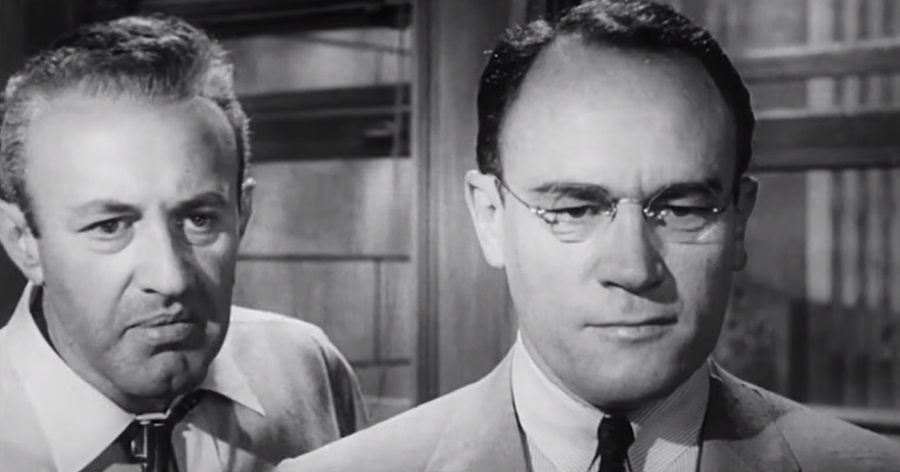12 Angry Men is a classic American courtroom drama film directed by Sidney Lumet, released in 1957. The film is based on Reginald Rose's teleplay of the same name and explores the dynamics of a jury as they deliberate the guilt or innocence of a young man accused of murder. The entire film takes place within the confines of a jury room, intensifying the focus on the characters and their interactions. The story unfolds in real-time, capturing the tension and emotions that escalate as the jury members try to reach a unanimous verdict.
Plot Summary
12 Angry Men begins with a judge instructing the jury to reach a unanimous decision in the case of an 18-year-old defendant accused of murdering his father. The jury, composed of twelve men from various backgrounds, retires to a small, stuffy deliberation room. The initial vote is overwhelmingly "guilty," with only Juror #8 (Henry Fonda) dissenting.
Juror #8 believes in the importance of thorough deliberation and reasonable doubt. He presents alternative theories and questions the reliability of the evidence, urging his fellow jurors to consider the possibility of the defendant's innocence. The tension rises as the other jurors, initially dismissive, are forced to confront their biases and preconceptions.
As the deliberations unfold, conflicts arise among the jurors. Personal prejudices, biases, and preconceived notions surface, leading to heated debates. Juror #3, in particular, harbours a deep resentment towards the accused due to his strained relationship with his own son. Juror #8 continues to present compelling arguments, gradually swaying some jurors to his side.
The Turning Point
The turning point occurs when Juror #9 (the elderly man) reveals that he changed his vote to support Juror #8, not because he necessarily believes in the defendant's innocence, but because he wants to explore the possibility. This prompts further reevaluation from other jurors, and the tide begins to turn.
Unraveling the Case
Juror #8 systematically dismantles the prosecution's case, challenging eyewitness testimony, the murder weapon's uniqueness, and the supposed alibi. The jurors reenact critical moments, exposing inconsistencies and casting doubt on the prosecution's version of events. As uncertainties multiply, more jurors change their votes, leading to a growing sense of doubt.
Overcoming Prejudice
Juror #10's bigotry becomes a focal point as he delivers a venomous monologue. Other jurors, disgusted by his prejudice, distance themselves from him, contributing to the atmosphere of open-mindedness and empathy. The film poignantly addresses themes of justice, discrimination, and the importance of setting aside personal biases in the pursuit of truth.
The Verdict
As the jury inches closer to a unanimous decision, Juror #3, the most adamant "guilty" voter, experiences a breakdown. He reveals his deep-seated issues with his son, projecting his anger onto the accused. This emotional revelation forces him to reconsider, and the final vote turns in favour of acquittal. The jury, once divided, achieves unanimity in its decision to find the defendant not guilty.
Resolution
The film concludes with the jurors leaving the deliberation room. Juror #8 and Juror #9 exchange a brief moment of acknowledgment, recognizing the impact of their dedication to justice. The accused, whose fate hung in the balance, is spared from a potentially unjust conviction.
Themes
Justice and Fairness
The film explores the principles of justice and the responsibility of the jury to deliberate thoroughly. It emphasizes the importance of considering reasonable doubt and the potential consequences of a hasty decision.
Prejudice and Bias
12 Angry Men addresses the pervasive influence of personal prejudices and biases on decision-making. It underscores the need for jurors to confront and overcome their preconceptions to ensure a fair trial.
Power of Persuasion
Juror #8's calm and logical approach to deliberation highlights the power of persuasion. His ability to challenge assumptions and present alternative perspectives demonstrates the impact of critical thinking and open-mindedness.
Group Dynamics
The film delves into the dynamics of group decision-making, showcasing how individual personalities, backgrounds, and beliefs can shape the deliberation process. It raises questions about conformity, peer pressure, and the difficulty of maintaining independence within a group.
The Ending of 12 Angry Men Explained
12 Angry Men concludes with the jurors leaving the deliberation room after reaching a unanimous "not guilty" verdict. Juror #8, the protagonist, and Juror #9 share a subtle moment of mutual understanding, acknowledging the significance of their commitment to justice. The accused, who faced the death penalty, is spared from an unjust conviction, and the system ultimately works as intended.
The ending is powerful in its simplicity. It reinforces the triumph of reason, compassion, and the pursuit of truth over prejudice and haste. The transformation of Juror #3, from an obstinate and angry voter to a broken man confronting his own demons, adds depth to the conclusion. The film suggests that the justice system, flawed as it may be, can succeed when individuals are willing to engage in honest and open deliberation.
The final scene, where the jurors disperse into the outside world, symbolizes the broader impact of their collective decision. It implies that the lessons learned in the deliberation room extend beyond the confines of that space, influencing the jurors' future perspectives and actions.






